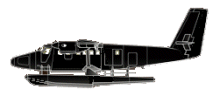Incident Overview

Description
The pilot and owner of float equipped DHC-6 Twin Otter C-FWAH (and founder of Wardair) flew from Edmonton/Cooking Lake to the Yellowknife Water Aerodrome. There were three passengers and about 700 pounds of supplies on board. Upon arrival at Yellowknife, the pilot selected full fine pitch on the propellers, then selected 20 degrees of flap for the cross wind landing, to the north, at the Back Bay. Upon touchdown, the aircraft porpoised, bounced back into the air, then porpoised again and bounced back into the air. On the third bounce, the left wing dropped, the left float dug into the water and the aircraft swerved to the left. The right wing then dug into the water and became detached from the aircraft. The aircraft came to a stop resting on its damaged floats. The four occupants vacated the substantially damaged aircraft and were rescued, within minutes, by a nearby power boat operator. There were no injuries. The wind was from 100 degrees true at 13 knots and visibility was 15 statute miles.
Primary Cause
Uncontrolled Maneuvering during Landing ? Combination of propeller settings and flap configuration.Uncontrolled Maneuvering during Landing ? Combination of propeller settings and flap configuration.Share on:





